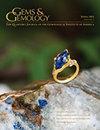The Gemological Characteristics of Pipi Pearls Reportedly from Pinctada Maculata
IF 1.6
3区 地球科学
Q2 MINERALOGY
引用次数: 3
Abstract
“tiny” and is used to refer to the small, predominantly yellow or “golden” pearls that originate from the bivalve mollusk Pinctada maculata (Gould, 1846). As the smallest mollusk species in the Pinctada genus, Pinctada maculata rarely exceeds 5 cm when measured in the anterioposterior or dorsoventral positions. The mollusk lives in the Indo-Pacific Ocean, mostly around French Polynesia and the Cook Islands, where they are often found in association with the Pinctada margaritifera mollusk species (Strack, 2006). Pearls from Pinctada maculata often form in round to near-round shapes. As the name implies, the small shells produce small pearls that rarely exceed 8 mm in diameter (Krzemnicki, 2014). Based on GIA’s experience, 6 mm or under is more typical of the species. Pipi pearls are known to occur as natural pearls rather than cultured and, compared with other Pinctada species, are deemed rare. One report recorded only one gem-quality pearl found from a total of 355 mollusks (Passfield, 1997). In 1950, several cultured pearl experiments using Pinctada maculata reportedly took place but were unsuccessful (Segura et al., 2014). In the late 1990s, a few Pinctada maculata cultured blister pearls resulted from experiments in the waters off Penrhyn, an island in the northern atoll of the Cook Islands (Kessrapong et al., 2017). The nacre covering the bead nuclei did not fully overgrow the nuclei, however, and this attempt was not very successful. Some reports suggest that the Pinctada maculata mollusk is not abundant enough for马库拉塔珠母贝皮皮珍珠的宝石学特征
“微小的”,用来指源自双壳纲软体动物斑珠母贝的以黄色或“金色”为主的小珍珠(Gould,1846)。作为斑螯蛛属中最小的软体动物,斑螯蛛在前腹或腹后位置测量时很少超过5厘米。这种软体动物生活在印度洋-太平洋,主要分布在法属波利尼西亚和库克群岛附近,在那里,它们经常与玛格丽蒂菲拉珠母贝软体动物物种有关(Strack,2006)。斑珠母贝的珍珠通常呈圆形至近圆形。顾名思义,小贝壳产生的小珍珠直径很少超过8毫米(Krzemnicki,2014)。根据GIA的经验,6毫米或以下是更典型的物种。众所周知,皮皮珍珠是天然珍珠,而不是人工养殖的,与其他珠母贝物种相比,皮皮珠被认为是罕见的。一份报告只记录了从355种软体动物中发现的一颗宝石级珍珠(Passfield,1997)。1950年,据报道,使用斑珠母贝进行了几次养殖珍珠实验,但均未成功(Segura等人,2014)。20世纪90年代末,在库克群岛北部环礁的Penrhyn岛附近海域进行的实验中,发现了一些斑螯蛛养殖的水泡珍珠(Kesrapong et al.,2017)。然而,覆盖珠核的珍珠层并没有完全使珠核过度生长,这种尝试并不十分成功。一些报告表明,斑螯软体动物的数量不足
本文章由计算机程序翻译,如有差异,请以英文原文为准。
求助全文
约1分钟内获得全文
求助全文
来源期刊

Gems & Gemology
地学-矿物学
CiteScore
2.90
自引率
19.20%
发文量
10
期刊介绍:
G&G publishes original articles on gem materials and research in gemology and related fields. Manuscript topics include, but are not limited to:
Laboratory or field research;
Comprehensive reviews of important topics in the field;
Synthetics, imitations, and treatments;
Trade issues;
Recent discoveries or developments in gemology and related fields (e.g., new instruments or identification techniques, gem minerals for the collector, and lapidary techniques);
Descriptions of notable gem materials and localities;
Jewelry manufacturing arts, historical jewelry, and museum exhibits.
 求助内容:
求助内容: 应助结果提醒方式:
应助结果提醒方式:


